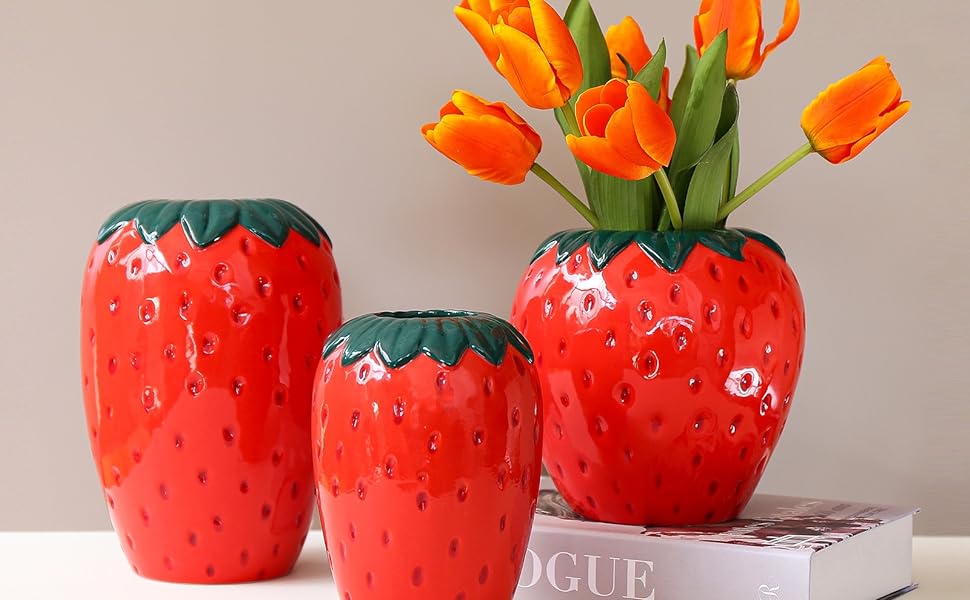Growing strawberries in a vase is a unique and innovative way to maximize space while enjoying fresh berries. This vertical approach to strawberry gardening allows you to cultivate luscious strawberries without a sprawling garden. Whether you’re an urban gardener with limited space or simply looking to add a striking visual element to your garden, a strawberry vase can be a game-changer. In this article, we’ll explore 10 proven tips to master the art of strawberry vase gardening, offering you guidance on setup, care, and maximizing your harvest.
Choosing the Right Strawberry Vase
Selecting the right strawberry vase is crucial to your success. Look for vases designed specifically for vertical gardening, with multiple openings to accommodate strawberry plants. Consider the vase’s material; durable options like ceramic, terracotta, or plastic are popular. Ensure it’s sturdy enough to withstand the weight of soil and plants, and check for adequate drainage to prevent waterlogging.
Optimal Soil Selection for Strawberry Vase
The soil you choose will impact your strawberry-vase’s health and productivity. Use a well-draining potting mix designed for container gardening, as it will help prevent root rot. Consider adding organic matter like compost or aged manure to enrich the soil. A balanced mix with adequate aeration is essential for healthy root development.
Planting Techniques for Strawberry Vase
When planting in a strawberry-vase, positioning is key. Start by filling the vase with soil up to the first set of openings. Insert your strawberry plants through the openings, ensuring the roots are covered with soil. Continue this process layer by layer, making sure each plant is securely in place. Water the vase thoroughly to settle the soil around the roots.
Watering Strategies for Strawberry Vase
Watering a strawberry vase requires a gentle approach to avoid washing out soil or damaging plants. Use a watering can with a fine spout to evenly distribute water throughout the vase. Aim to keep the soil consistently moist but not saturated. In hot weather, you may need to water more frequently, while cooler weather requires less frequent watering.
Feeding and Fertilizing Strawberry-Vases
Strawberries are heavy feeders, and regular fertilization is necessary for a bountiful harvest. Use a balanced fertilizer, like a 10-10-10 formula, every few weeks during the growing season. Liquid fertilizers can be easier to apply evenly in a strawberry vase. Be cautious not to over-fertilize, as this can lead to excessive foliage growth with fewer fruits.
Pruning and Maintenance for Strawberry Vase
Regular maintenance is crucial to keep your strawberry vase healthy and productive. Prune away dead or yellowing leaves to promote air circulation and reduce disease risk. Remove runners if you want to focus on fruit production rather than plant propagation. Periodically check for pests and diseases, and address them promptly to prevent spread.
Sunlight and Location for Strawberry-Vases
Strawberries thrive in full sun, so choose a location for your strawberry vase that receives at least 6-8 hours of sunlight per day. If you’re gardening indoors or in a shaded area, consider using grow lights to supplement natural sunlight. Proper sunlight exposure is critical for fruit development and overall plant health.
Managing Pests and Diseases in Strawberry-Vases
Pests and diseases can be a challenge in any garden, and strawberry-vases are no exception. Keep an eye out for common strawberry pests like aphids, spider mites, and slugs. Use organic pest control methods or insecticidal soaps to address infestations. Disease prevention involves proper spacing, good air circulation, and avoiding overwatering.
Harvesting Techniques for Strawberry-Vases
Harvesting strawberries from a vase is a delightful experience. Pick ripe strawberries when they are fully red and slightly soft to the touch. Use scissors or garden shears to cut the stem above the fruit, rather than pulling, to avoid damaging the plant. Harvest regularly to encourage more fruit production and enjoy the sweetest strawberries.
Off-Season Care for Strawberry-Vases
At the end of the growing season, prepare your strawberry vase for the off-season. If you live in a cold climate, consider moving the vase indoors or to a sheltered location to protect it from frost. Prune back dead foliage and clean the vase thoroughly. Plan for replanting or rejuvenating the soil in the next growing season to ensure a healthy start.
Conclusion
Growing strawberries in a vertical structure offers a creative and space-saving way to cultivate your own berries. By applying the 10 tips provided, you can maximize your harvest while maintaining a healthy and vibrant garden. This approach not only yields a generous crop of strawberries but also adds a visually appealing element to your gardening space. With proper care, regular maintenance, and a focus on optimal growing conditions, you will be rewarded with fresh, sweet strawberries throughout the growing season.
FAQs
Q1. How many strawberry plants should I plant in one vertical container?
The number of plants depends on the container’s size and design. Typically, you can plant 6 to 12 individual plants in a medium to large vertical setup. Make sure each plant has enough space for root growth and ample access to light.
Q2. Can I grow strawberries indoors using vertical gardening techniques?
Yes, you can grow strawberries indoors with vertical methods. Ensure they receive sufficient sunlight, either from a sunny window or with the help of grow lights. Proper air circulation and humidity control are also important to prevent mold and other issues.
Q3. How often should I water vertical strawberry planters?
Watering frequency depends on weather conditions and the container’s size. Generally, you should water when the top inch of soil feels dry to the touch. During hot weather, you may need to water daily; in cooler conditions, every few days might be sufficient.
Q4. What are the best strawberry varieties for vertical gardening?
Ever-bearing and day-neutral varieties are best suited for vertical growth because they produce fruit throughout the growing season. Some popular choices include ‘Albion,’ ‘Seascape,’ and ‘Mara des Bois,’ which are known for their flavor and high yield.
Q5. Is it possible to reuse soil in vertical strawberry planters for the next growing season?
While it is possible to reuse soil, it’s best to refresh it or add new organic matter to maintain soil fertility and reduce the risk of diseases. If reusing soil, ensure it’s sterilized and supplemented with compost or another nutrient-rich material to give your plants the best start for the new season.
Also read: Bathroom with Window Wonders: 10 Reasons Why It’s a Must-Have





